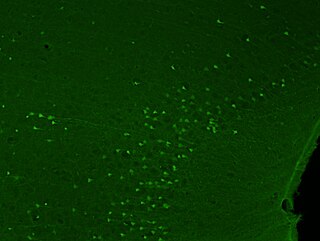
Triamcinolone acetonide, sold under the brand name Kenalog among others, is a synthetic corticosteroid medication used topically to treat various skin conditions, to relieve the discomfort of mouth sores, and by injection into joints to treat various joint conditions. It is also injected into lesions to treat inflammation in some parts of the body, particularly the skin. In nasal spray form, it is used to treat allergic rhinitis. It is used for the treatment of macular edema associated with uveitis. It is a more potent derivative of triamcinolone, and is about eight times as potent as prednisone.
Hydrazides in organic chemistry are a class of organic compounds with the formula R−NR1−NR2R3 where R is acyl, sulfonyl, phosphoryl, phosphonyl and similar groups, R1, R2, R3 and R' are any groups. Unlike hydrazine and alkylhydrazines, hydrazides are nonbasic owing to the inductive influence of the acyl, sulfonyl, or phosphoryl substituent.

Floxuridine is an oncology drug that belongs to the class known as antimetabolites. Specifically, floxuridine is a pyrimidine analog, classified as a deoxyuridine. The drug is usually administered via an artery, and most often used in the treatment of colorectal cancer. The quality of life and survival rates of individuals that receive continuous hepatic artery infusion of floxuridine for colorectal cancer metastases is significantly higher than control groups. Floxuridine can also be prescribed for the treatment of kidney and stomach cancers. In vitro uses of floxuridine include 5-minute treatments of fluorouracil, floxuridine, and mitomycin to increase cell proliferation in Tenon's capsule fibroblasts.

Eticyclidine is a dissociative anesthetic drug with hallucinogenic effects. It is similar in effects to phencyclidine but is slightly more potent. PCE was developed by Parke-Davis in the 1970s and evaluated for anesthetic potential under the code name CI-400, but research into PCE was not continued after the development of ketamine, a similar drug with more favourable properties. PCE is slightly more potent than PCP and has similar effects, but its unpleasant taste and tendency to cause nausea made it less accepted by users. Due to its similarity in effects to PCP, PCE was placed into the Schedule 1 list of illegal drugs in the 1970s, although it was only briefly abused in the 1970s and 1980s and is now little known.

Panadiplon (U-78875) is an anxiolytic drug with a novel chemical structure that is not closely related to other drugs of this type. It has a similar pharmacological profile to the benzodiazepine family of drugs, but with mainly anxiolytic properties and relatively little sedative or amnestic effect, and so is classified as a nonbenzodiazepine anxiolytic.

RWJ-51204 is an anxiolytic drug used in scientific research. It has similar effects to benzodiazepine drugs, but is structurally distinct and so is classed as a nonbenzodiazepine anxiolytic.

Fluoro-jade stain is a fluorochrome derived from fluorescein, and is commonly used in neuroscience disciplines to label degenerating neurons in ex vivo tissue of the central nervous system. The first fluoro-jade derivative was reported by Larry Schmued in 1997 as an alternative method from traditional methods for labeling degenerating neurons such as silver nitrate staining, H&E stain, or Nissl stain. Fluoro-jade may be preferred to other degenerative stains due to simplicity of staining procedures and visual interpretation, which are common drawbacks of conventional degenerative stains. However, the mechanism by which fluoro-jade labels degenerating neurons is unknown thus creating some controversy to the actual physiological condition of the labeled cells.

Isoethcathinone is a designer drug with purportedly stimulant effects, first encountered in Ireland in 2010 and reported to the EMCDDA new drug monitoring service. It is unclear whether it has desirable pharmacological properties in its own right, or is merely an impurity from the synthesis of ethcathinone.

N-Ethylnorketamine is a designer drug which is presumed to have similar properties to ketamine, a dissociative anesthetic drug with hallucinogenic and sedative effects. It has been sold over the internet since around September 2012, and identified in seized drug samples by analytical laboratories in the UK and other European countries.

AB-CHFUPYCA is a compound that was first identified as a component of synthetic cannabis products in Japan in 2015. The name "AB-CHFUPYCA" is an acronym of its systematic name N-(1-Amino-3-methyl-1-oxoButan-2-yl)-1-(CycloHexylmethyl)-3-(4-FlUorophenyl)-1H-PYrazole-5-CarboxAmide. There are two known regioisomers of AB-CHFUPYCA: 3,5-AB-CHMFUPPYCA (pictured) and 5,3-AB-CHMFUPPYCA. The article[1] refers to both 3,5-AB-CHMFUPPYCA and 5,3-AB-CHMFUPPYCA as AB-CHMFUPPYCA isomers, so AB-CHMFUPPYCA and AB-CHFUPYCA are not names for a unique chemical structure.

3-Methoxyeticyclidine (3-MeO-PCE), also known as methoxieticyclidine, is a dissociative anesthetic that is qualitatively similar to PCE and PCP and has been sold online as a designer drug.

5F-AB-FUPPYCA (also known as AZ-037) is a pyrazole-based synthetic cannabinoid that is presumed to be an agonist of the CB1 receptor and has been sold online as a designer drug. It was first detected by the EMCDDA as part of a seizure of 540 g white powder in France in February 2015.

2-Fluorodeschloroketamine is a dissociative anesthetic related to ketamine. Its sale and use as a designer drug has been reported in various countries. It is an analogue of ketamine where the chlorine group has been replaced by fluorine. Due to its recent emergence, the pharmacological specifics of the compound are mostly unclear, but effects are reported to be similar to its parent compound, ketamine.

Flugestone acetate (FGA), sold under the brand name Cronolone among others, is a progestin medication which is used in veterinary medicine.

2-Oxo-PCE is a dissociative anesthetic of the arylcyclohexylamine class that is closely related to deschloroketamine and eticyclidine, and has been sold online as a designer drug.

2-Bromodeschloroketamine is a chemical compound of the arylcyclohexylamine class, which is an analog of the dissociative anesthetic drug ketamine in which the chlorine atom has been replaced with a bromine atom. It is used in scientific research as a comparison or control compound in studies into the metabolism of ketamine and norketamine, and has also been sold online alongside arylcyclohexylamine designer drugs, though it is unclear whether bromoketamine has similar pharmacological activity.

3-Fluoro-PCP is a recreational designer drug from the arylcyclohexylamine family, with dissociative effects. It was first identified in Slovenia in October 2020, and was made illegal in Hungary in April 2021.

Deoxymethoxetamine is a recreational designer drug from the arylcyclohexylamine family, with dissociative effects. It is an analogue of methoxetamine where the 3-methoxy group has been replaced by methyl. It has been sold online since around October 2020, and was first definitively identified by a forensic laboratory in Denmark in February 2021.

2F-NENDCK is a recreational designer drug from the arylcyclohexylamine family, with dissociative effects. It was first identified in Australia in 2022, and has subsequently been found in China and Taiwan.


















